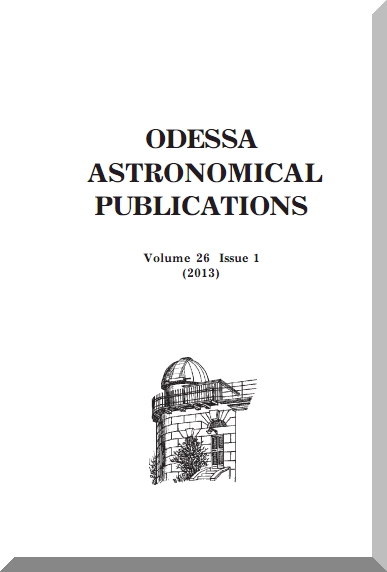THE NUMERICAL THREE-DIMENSIONAL HYDRODYNAMIC SIMULATION OF THE γ-RAY BURSTERS AND X-RAY BURSTERS
DOI:
https://doi.org/10.18524/1810-4215.2013.26.81910Ключові слова:
Stars, close binary system, X-ray bursters, gamma-ray burstersАнотація
An radiative wind accretion on to the compact object in a detached close binary system (CBS) where one of the components is a supergiant with radiation stellar wind that blows from its surface, and another component is a compact object (black hole or neutron star), is simulated applying methods of three-dimensional numerical hydrodynamics. The simulation of bursts similar to the gamma-ray bursters and X-ray bursters, i.e. isolated bursts with nearly zero in time ascending and descending branches with amplitudes from 6 –– 7m to15 –– 18m, commences in the vicinity of the compact object when the precession of the donor star starts. Due to the course numerical spatial grid of 0.01 units of the orbital separation, the duration of such isolated bursts is 10-40 minutes of the orbital time. The burst simulation is as follows: when the donor stars precession starts, small grid-cell-sized regions of higher density appear in the vicinity of the compact object due to the Rayleigh Taylor instability. The temperature in one of those regions increases abruptly when they interact with the stellar wind from the donor star. Prior to the temperature increase, the indicated regions were radiopaque. When the temperature reaches it speak, those regions become radiolucent, and all energy contained there is momentarily illuminated, giving off a burst that appears as an isolated sharp peak. That is how the bursts similar to the γ-ray bursts and X-ray bursts are simulated
Посилання
Castor J.I., Abbot D.C., Klein R.I. : 1975, Astrophys. J., 195, 157
Cox D.P., Daltabuilt E.: 1971, ApJ, 167, 113
Grindlay J.E, McClintock J.E., Canizares C.R. et. al.: 1978, Nature, 274, 567.
McClintock J.E., Bradt H.V., Doxsey R.E. et. al.: 1977, Nature, 270, 320
Nazarenko V.V.: 2006, Astron. Rep., 50, 647
Nazarenko V.V.: 2008, Astron. Rep., 52, 40
Nazarenko V.V., Glazunova L.V.: 2005, Astron. Rep., 49, 826
Nazarenko V.V., Glazunova L.V.: 2006, Astron. Rep., 50, 369
Nazarenko V.V., Glazunova L.V.: 2006, Astron. Rep., 50, 380
##submission.downloads##
Опубліковано
Як цитувати
Номер
Розділ
Ліцензія
Авторське право (c) 2016 Odessa Astronomical Publications

Ця робота ліцензується відповідно до Creative Commons Attribution-NonCommercial 4.0 International License.
Відповідно Закону України про авторське право і суміжні права N 3792-XII від 23 грудня 1993 року
